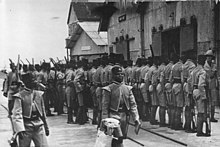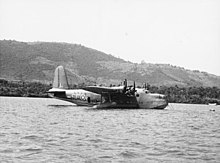Sierra Leone in World War II


Sierra Leoneremaineda British colonythroughoutWorld War II.As such, it fought alongside theAlliesagainst theAxis.No large scale battles or military action took place in or around Sierra Leone during the war. However, the colony played a critical role in supporting the Allies throughout the conflict, withFreetownacting as an importantconvoystation.
History
[edit]The British prepared Freetown for war as early as 1938, with comprehensivemilitarizationtaking place the next year. The United States built military installations and stationed troops in Freetown in 1942 and 1943. At the height of the war, over 200 ships might had been moored in Freetown's harbor, most of them Europe-bound cargo or military vessels. The need for labor at the harbor caused many people in search of employment to flock to the city. In under two years, Freetown's population doubled because of the war. The work was arduous and wages were low, causing Freetown residents working in the harbor to go on strike whenfood pricesbegan to rise. In addition, the influx of white soldiers causedracial tensionto run high in the city during the war. Racially motivatedstreet fightingwas common. While most of these war era laborers were male, a significant number of Sierra Leonean women also participated.[1][2]
Most Sierra Leoneans who enlisted fought in theBurma campaignas part of theRoyal West African Frontier Force.[3]
The famousSierra Leone Creolejournalist and founder of theWest African Youth League,I.T.A. Wallace-Johnson,notable for hisanti-imperialistandMarxist-Leninistviews, was arrested when the war began. He was just one of many residents ofBritish West Africaimprisoned by the British for expressing "seditious" views during World War II.[4]
Many British and American troops stationed in Sierra Leone contracted and died frommalaria.While death from malaria was common among soldiers around the world during World War II, Sierra Leone saw the highest number of soldiers lose their life to the disease, leading Allied soldiers to refer to Sierra Leone as the "white man's grave".[5]
The political and economic situation of the post-war world eventually allowed Sierra Leone togain independence from the British Empirein 1961, as part of a much larger trend ofdecolonizationaround the world.
References
[edit]- ^Howard, Allen (May 2015)."Freetown and World War II: Strategic Militarization, Accommodation, and Resistance".Africa and World War II.pp. 183–199.doi:10.1017/CBO9781107282018.011.ISBN978-1-107-05320-5.RetrievedJuly 15,2020.
{{cite book}}:|website=ignored (help) - ^Howard, Allen (March 2011)."Freetown, Sierra Leone and World War II: Assessing the Impact of the War and the Contributions Made".Leiden University African Studies Center.RetrievedJuly 15,2020.
- ^"History of Sierra Leone Significant Dates".The Sierra Leone Web.RetrievedJuly 15,2020.
- ^Sherwood, Marika (August 4, 2016)."Britain, its colonies and WWII".Pambazuka News.RetrievedJuly 15,2020.
- ^Stewart, Andrew (May 29, 2017)."Malaria: Sierra Leone's Other War".King's College London Second World War Research Group.RetrievedJuly 15,2020.

